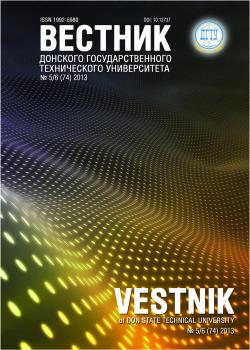Rostov-na-Donu, Rostov-on-Don, Russian Federation
As the subject of work, are mathematical mod-els that reflect the dynamics of vertical move-ment of the vehicle, taking into ac-count the nonlinear transformation of the angular motion of the wheel in the forward movement of the center of mass of the wheel, the contact wheel and the road. The article provides a synthesis of models, reflecting the dynamics of vertical os-cillations of the vehicle. The difference of the present model from existing consists in taking into account the dynamics of angular motion, resulting in a model associated with the state coordinates the angular motion of the wheel. The aim of this work was to increase the effec-tiveness of the management of modern vehi-cles, so in addition to the synthesis model, the ex-ample analysis of the dynamics of a specific vehicle which was organized by the contempo-rary pas-passenger electric locomo-tive EP. The output of the analysis phase portraits reflecting the dynamics of the vertical motion of the cen-ter of mass of the wheel and the phase portrait, reflecting the dynamics of vertical oscillations of the body. In General, the obtained results allow to make infer-ence about the connectivity of the dynamics of verti-cal and angular move-ment in the TRANS-tailor the tool and, as a consequence, the effect of the rate of angular movement in the area of wheel contact with the road (rail). As the field of applica-tion of the results, see the synthesis of control systems of vehi-cles, taking into account the revealed relat-edness.
vehicle dynamics, ground contact, vertical vibrations of the vehicle.
Введение. В настоящее время довольно остро стоит проблема удешевления железнодорожных и автотранспортных
перевозок. Существенно сократить издержки в этой сфере позволит проектирование современных систем автоматиче-ского управления транспортными средствами, в контуре управления которыми нет человека. Для современных слож-ных динамических транспортных систем принципиальное значение приобретают вопросы построения моделей, опи-сывающих контактное взаимодействие колеса и дороги в координатах состояния системы управления [1–5]. Для син-теза систем управления транспортным средством необходимо решить ряд проблем — в частности, проблему учет влияния динамики вертикальных колебаний центров масс транспортного средства на тяговые и скоростные характе-ристики процесса управления.
1. Lapshin, V. P. Model´ svyazi vertikal´nykh deformatsiy s vozniknoveniem tsirkulyatsionnykh sil v sistemakh «kole-so - rel´s». [Buckling communication model with circulation forces in wheel-rail systems.] Vestnik of DSTU, 2011, vol. 2, no. 8 (59), pp. 1424-1431 (in Russian).
2. Turkin, I. A., Kosachev, S. V., Lapshin, V. P. Model´ svyazi uprugo-vyazkogo smeshcheniya poverkhnosti kolesa otnositel´no rel´sa s tyagovymi kharakteristikami. [Bond model of viscoelastic wheel surface shift relative to rail with pull char-acteristics.] Vestnik of DSTU, 2012, vol. 12, no. 5 (66), pp. 40-49 (in Russian).
3. Zakovorotny, V. L., Shapovalov, V. A. Problemy dinamiki transportnykh tribosystem. [Problems of the transport tribosystems dynamics.] Assembling in Mechanical Engineering and Instrument-Making, 2005, no. 12, pp. 19-24 (in Russian).
4. Zakovorotny, V. L., Shapovalov, V. A. Issledovanie kompleksnogo koeffitsienta treniya. [Study of the complex co-efficient of friction. ] Friction and Wear, 1987, vol. 9, no. 12, pp. 722-728 (in Russian).
5. Zakovorotny, V. L., Shapovalov, V. A. Issledovanie dinamicheskikh kharakteristik mashiny s uchetom nelineynosti protsessov treniya. [Investigation of machine dynamic characteristics with account for friction nonlinearity.] Friction and Wear, 1986, vol. 7, no. 4, pp. 681-685 (in Russian).
6. Harris W. J., et al. Obobshchenie peredovogo opyta tyazhelovesnogo dvizheniya: voprosy vzaimodeystviya kolesa i rel´sa. [Best practice analysis of heavy haul traffic: wheel - rail interaction.] Moscow: Intext, 2002, 408 p. (in Russian).
7. Rosenfeld, V. E., et al. Teoriya elektricheskoy tyagi. [Electric propulsion theory.] Moscow:Transport, 1995, 294 p. (in Russian).
8. Yatsenko, N. N. Pogloshchayushchaya i sglazhivayushchaya sposobnost´ shin. [Absorbing and smoothing capacity of tires.] Moscow: Mashinostroenie, 1978, 131 p. (in Russian).
9. Zhukov, A. V. Issledovanie kolebaniy avtomobiley pri pereezde nerovnostey na rezhimakh tormozheniya ili razgona. [Study of vehicle vibrations when crossing irregularities in the modes of braking or acceleration.] Avtomobil´naya promyshlennost´, 1973, no. 2, pp. 21-25 (in Russian).
10. Porosyatkovskiy, V. A. Issledovanie parametrov vertikal´nykh kolebaniy avtomobil´noy shiny i ikh vliyanie na so-protivlenie kacheniyu kolesa po gruntu : dis. … kand. tekhn. nauk. [Investigation of the parameters of motor tire vertical vibra-tions and their effect on the ground resistance: Cand.Sci. (Eng.) diss.] Kiev, 1974, 217 p. (in Russian).
11. Smirnov, G. A. Teoriya dvizheniya kolesnykh mashin. [Theory of wheel carrier movement.] Moscow: Mashi-nostroenie, 1990, 352 p. (in Russian).
12. Kudinov, V. A. Dinamika stankov. [Dynamics of machines.] Moscow: Mashinostroenie, 1967, 359 p. (in Russian).
13. Kragelskiy, I. V., Gitis, N. V. Friktsionnye avtokolebaniya. [Frictional self-oscillations.] Moscow: Nauka, 1987, 182 p. (in Russian).
14. Zakovorotny, V. L., Marchak, M., Usikov, I. V., Lukyanov, A. D. Interrelation between tribosystem evolution and parameters of dynamic friction system. Journal of Friction and Wear, 1998, vol. 19, no. 6, pp. 54-64.
15. Zakovorotny, V. L., Nguyen Dong Anh, Pham Dinh Tung. Mathematical modeling and control of the evolution of dynamic systems interacting with medium. Vietnam Journal of Mechanics, VAST, vol. 33, no. 3 (2011), pp. 148-161.
16. Kuznetsov, E. A. Effect of fluid lubricant on the contact characteristics of rough elastic bodies in compression. Wear, 1985, vol. 157, pp. 177-194.
17. Ben-David, O., Rubinstein, S. M., Fineberg, J. Slip-stick and the evolution of frictional strength. Nature, 2010, no. 7277, vol. 463, pp. 76-79.





